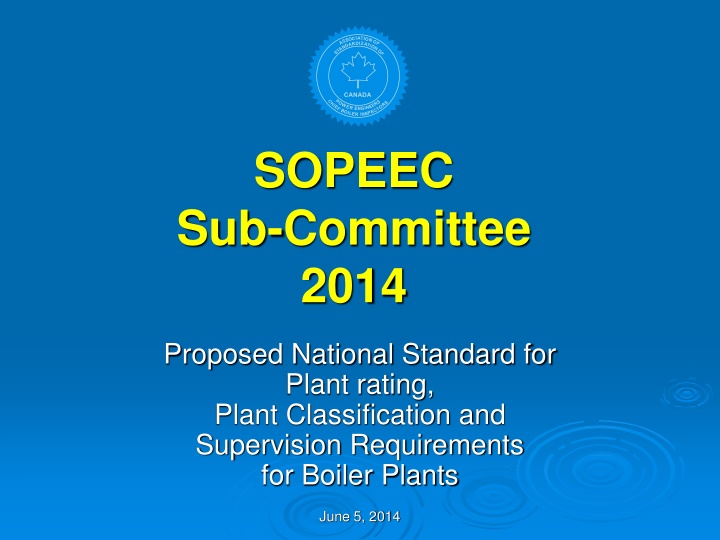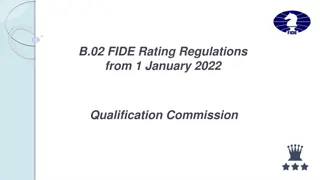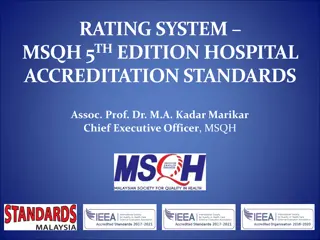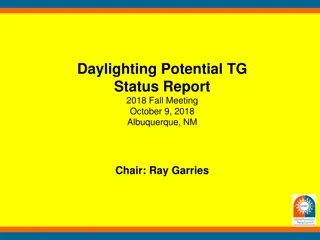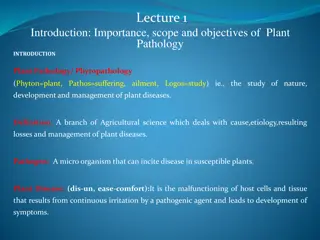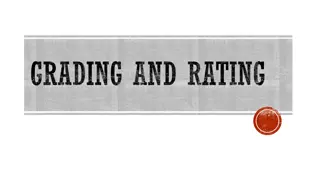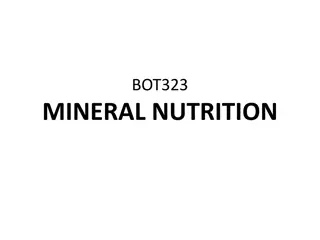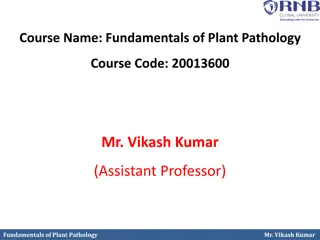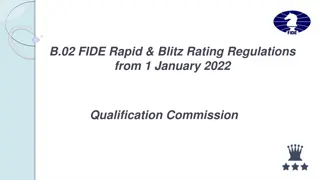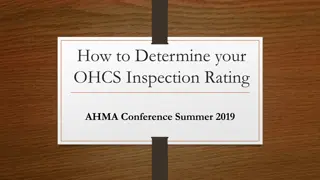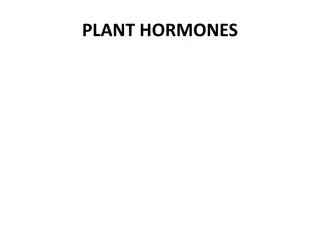Proposed National Standard for Plant Rating and Classification
The SOPEEC Sub-Committee in 2014 proposed a national standard for plant rating and classification for boiler plants in Canada. This initiative aims to establish uniform regulations for the safe management and operation of boilers, steam prime movers, compressors, and refrigeration technologies. The lack of a national standard led to varying regional practices, necessitating the development of a cohesive framework. Additionally, the sub-committee recommended differentiation in boiler management based on pressure and temperature parameters.
Download Presentation

Please find below an Image/Link to download the presentation.
The content on the website is provided AS IS for your information and personal use only. It may not be sold, licensed, or shared on other websites without obtaining consent from the author.If you encounter any issues during the download, it is possible that the publisher has removed the file from their server.
You are allowed to download the files provided on this website for personal or commercial use, subject to the condition that they are used lawfully. All files are the property of their respective owners.
The content on the website is provided AS IS for your information and personal use only. It may not be sold, licensed, or shared on other websites without obtaining consent from the author.
E N D
Presentation Transcript
SOPEEC Sub-Committee 2014 Proposed National Standard for Plant rating, Plant Classification and Supervision Requirements for Boiler Plants June 5, 2014
SOPEEC Uniform Plant Rating, Plant Classification for Canada Currently Canada does not have a national standard for the classification, rating and supervision of boilers, steam prime movers, compressors and refrigeration technologies. Each national region primarily applies variable plant ratings as the basic risk consideration for levels of supervision. June 5, 2014 2
In 2009 National Public Safety Advisory Committee of Canada (NPSAC) requested that a national standard be developed. The intent is to provide a uniform Canadian standard for the safe management and operation of boilers. June 5, 2014 3
It is equally desired that a similar rationale be applied to the technologies of Steam Prime Movers, Compression and Refrigeration in order to provide a national standard, as may be regionally required, for safe and uniform regulation of all Canadian power plants June 5, 2014 4
Power Engineering Scope of Knowledge 1st Class No restrictions. 100 % body of knowledge 2nd Class No restrictions on being the shift engineer. Restrictions on being the chief engineer. 80% body of knowledge 3Rd Class Restrictions on being the shift engineer and a chief engineer. 40 % body of knowledge The arrow represents the body of knowledge obtained 4th Class Entry level. Restrictions on being the shift engineer and a chief engineer. 20% body of knowledge June 5, 2014 5
Proposed Model for Boiler Plant Rating Traditionally boilers in plants have been classified as either being high pressure or low pressure boilers. In most cases boilers operating above 101 kPa (15 psi ) steam and 1103 kPa (160 psi ) hot water were classified as being high pressure and or power boilers. Boilers operating at or below 101 kPa (15 psi ) steam and 1103 kPa (160 psi ) hot water were classified as low pressure and or heating boilers. June 5, 2014 6
It is recommended by the sub-committee relative to boiler management and operation differences between Low and High Pressure Steam and High Temperature Hot Water that it cannot warrant the regulation of pressure and temperature segregation. June 5, 2014 7
Benefits of Proposed Change The benefits of eliminating pressure and temperature segregation includes: the current classification and supervisory requirements are primarily based on the risk factor of boiler energy rating rather than pressure/temperature simplified regulations reduced regulation impact on industry a Standard Power Engineers Operating Allowance increased practical opportunities for 4th and 3rd class engineers in relation to their academic knowledge June 5, 2014 8
The proposed model is designed to encourage a central boiler room and a reduced number of boilers. This will provide a reduction of equipment failures, reduced maintenance, plant operating errors, and increased safety. June 5, 2014 9
Proposed Model for Supervision Requirements: The traditional method of classifying boilers by pressure and temperature has been changed to steam or hot water. Boilers are now classified as either Steam or Hot Water. June 5, 2014 10
Five Risk Factors The proposed model would address five risk factors. 1. Total Installed kW Capacity (Steam & Water) 2. Single or Multiple Boilers 3. Number of Boiler Rooms 4. Boiler Type 5. Fuel Type June 5, 2014 11
Risk Factors Factor # 1 is the base number used to calculate boiler plant rating 1. Factors # 2 to # 5 add additional percentages to the base Factor #1 2. Factors # 2 to # 4 may have a significant impact towards the overall plant rating. June 5, 2014 12
Boiler Plant Classification Guarded boilers/plants are in yellow Steam Hot Water 2nd Class - > 30000 kW 3rd Class - 12001 kW to 30000 kW 4th Class - 8001 kW to12000 kW 4th Class - 7001 kW to 8000 kW 4th Class (8 hrs/day) - 4001 kW to 7000 kW 4th Class (1 insp./24hrs) - 2001 kW to 4000 kW Unattended 601 kW to 2000 kW Exempt - < 600 kW 1st Class - > 30000 kW 2nd Class - 12001 kW to 30000 kW 3rd Class - 8001 kW to 12000 kW 3rd Class - 7001 kW to 8000 kW 4th Class - 4001 kW to 7000 kW 4th Class (8 hrs/day) - 2001 kW to 4000 kW 4th Class (1 insp./24hrs) - 601 kW to 2000 kW Unattended 301 kW to 600 kW Exempt - < 300 kW Note: In the event that both Steam and Hot Water Boilers are in the same plant, the rating of both shall be combined and classified as the total rating under steam June 5, 2014 13
Determining Boiler Kilowatt Rating Boiler rating is expressed in kilowatt s. The boiler nameplate data as determined by the manufacturer is the source of the information. June 5, 2014 14
Determining Boiler Kilowatt Rating Applying lb/hr data X .284 = boiler kilowatt rating Applying kg/hr data X .625 = boiler kilowatt rating Applying ft heating surface data X 1 = boiler kilowatt rating Applying m2 heating surface data X 10 = boiler kilowatt rating Applying Btu/hr X 0.000293 = boiler kilowatt rating Note: kW = Boiler horsepower (bhp) X 10 June 5, 2014 15
Risk Factor # 1 Total Installed Capacity The total plant kilowatt rating for risk factor #1 is determined by adding the individual rating of all boilers. June 5, 2014 16
Examples Risk Factor # 1 Total Installed kW Capacity Example 3 Example 1 Example 2 Three Boiler Rooms Steam Boiler No. 1 = 1000 kW Steam Boiler No. 2 = 1000 kW Steam Boiler No. 3 = 1000 kW Steam Boiler No. 4 = 500 kW Steam Boiler No. 5 = 500 kW Steam Boiler No. 6 = 1500 kW Total Base kW rating = 5500 kW Single Boiler Room Steam Boiler No. 1 = 500 kW Steam Boiler No. 2 = 750 kW Total Base kW rating = 1250 kW Two boiler Rooms Steam Boiler No. 1 = 500 kW Steam Boiler No. 2 = 500 kW Steam Boiler No. 3 = 10,000 kW Steam Boiler No. 4 = 5000 kW Total Base kW rating = 16,000 kW June 5, 2014 17
Risk Factor # 2 Number of Boilers An additional risk factor in percentage is added to the plant installed kW rating for each additional boiler. This is to encourage a reduced number of boiler rooms Number of Boilers Percentage % 0% 1 2 10% 3 20% 4 30% 5 + 40% June 5, 2014 18
Example Risk Factor # 2 For each additional boiler over (1), a risk factor penalty of 10 percent is added to the total installed boiler kilowatt rating (base kW rating) to a maximum of 40 percent. Example 1 - 2 boilers = 10% Example 2 - 4 boilers = 30% Example 3 - 6 boilers = 40% June 5, 2014 19
Risk Factor # 3 Number of Boiler Rooms Number of Boiler Rooms 1 2 3 Percentage % An additional risk factor in percentage is added to the plant installed kW rating for each additional boiler room on site. 0% 20% 30% This is to encourage a reduced number of boiler rooms 4 5 60% 90% June 5, 2014 20
Risk Factor # 4 Boiler Types An additional risk factor in percentage is added to the installed plant kW total for the various boiler types being used in a plant. Unfired/electric Watertube (all types) = = = = 0% 2% 4% 5% HRT/Vertical / addendum B style Scotch Marine Dry Back/ Cast Iron Scotch Marine Wet Back/Firebox/Locomotive = 6% Note: If more than one type of boiler is installed then the highest rated boiler type will apply June 5, 2014 21
Example Risk Factor # 4 Boiler Types Example (1) Boiler #1 Example (3) = Scotch Marine Dryback Vertical Firetube Boiler #1 = Watertube Boiler #2 Boiler #3 Boiler #4 Boiler #5 Boiler #6 Additional = = = = = = Watertube Watertube HRT Firetube Cast Iron Watertube 5% Boiler #2 = Additional = 5% Risk Example (2) Boiler #1 = Scotch Marine Dryback Boiler #2 = Scotch Marine Wetback Wetback Boiler #3 = Watertube Boiler #4 = Electric Additional Risk = 6% Risk June 5, 2014 22
Risk Factor # 5 Fuel Types An additional risk factor in percentage is added to the installed plant kW total for the fuel types used. Unfired/electric = = = = = 0% 5% 10% 10% 20% Liquid Gas Solid Fuel Pulverized Black/Red Liquor = Automatic 1st Class Plant When multiple fuels are used the combustion percentage is the highest of all the fuel types plus 5%. June 5, 2014 23
Example Risk Factor # 5 Fuel Types Example (1) Example (2) Example (3) Gas = = 10% 5% Solid Liquid = = 10% 5% Pulverized Liquid = = 20% 5% Liquid 10% + 5% = 15% Gas = 10% Gas = 10% 10% + 5% = 15% 20% + 5% = 25% 15% to be added to the kW base rating. 15% to be added to the kW base rating. 25% to be added to the kW base rating. June 5, 2014 24
Total Plant Kilowatt Rating Real Case -Example 1 Boiler 1 500 kW - Liquid fired - Scotch marine dry back Boiler 2 750 kW Gas fired Vertical Located in one boiler room: 1. Total installed kilowatts 500 + 750 = 1250 kW 2. Two boilers = 10% 3. One boiler room = 0% 4. Boiler types = highest of the boiler types = 5% 5. Multiple fuels = 10% is the highest of the two fuels, so add 5 % = 15% 6. Total risk factor = 10 + 0 + 5 + 15 = 30% 7. Additional plant kilowatt risk rating = 1250 x .3 = 375 kW 8. Final plant rating 1250 + 375 = 1625 kW This plant is rated as a guarded 4th Class/1 inspection per 24 hour operation June 5, 2014 25
Real Case -Example 2 Boiler 1 500 kW - Liquid fired - Scotch marine dry back Boiler 2 500 kW Liquid fired Scotch marine wet back Boiler 3 - 10000 kW Solid fired Watertube Boiler 4 - 5000 kW Electric fired Located in two boiler rooms: 1. Total installed kilowatts 500 + 500 + 10000 + 5000 = 16000 kW 2. Four boilers = 30% 3. Two boiler rooms = 20% 4. Boiler types = highest of the boiler types = 6% 5. Multiple fuels = 10 % is the highest of the three fuels, so add 5 % = 15% 6. Total additional risk factor = 30 + 20 + 6 + 15 = 71% 7. Additional plant kilowatt risk rating = 16000 x .71 = 11360 kW 8. Final plant rating 16000 + 11360 = 27360 kW This plant is rated as a 2nd Class plant June 5, 2014 26
Real Case -Example 3 Boiler 1 - 1000 kW - Gas fired Watertube Boiler 2 - 1000 kW - Gas fired Watertube Boiler 3 - 1000 kW - Gas fired Watertube Boiler 4 - 500 kW - Liquid fired HRT Boiler 5 - 500 kW - Liquid fired Cast iron Boiler 6 - 1500 kW Solid Fuel Watertube Located in three boiler rooms: 1. Total installed kilowatts =1000 + 1000 + 1000 + 500 + 500 + 1500 = 5500 kW 2. Six boilers = 40% 3. Three boiler rooms = 30% 4. Multiple fuels = 10% is the highest of the three fuels, so add 5 % = 15% 5. Boiler types = highest of the boiler types = 5% 6. Total risk factor = 40 + 30 + 15 + 5 = 90% 7. Additional plant kilowatt risk rating = 5500 x .9 = 4950 kW 8. Final plant rating 5500 + 4950 = 10450 kW This is rated as a 3rd Class plant June 5, 2014 27
Definitions Boiler means a vessel in which steam or other vapour can be generated or in which a liquid can be heated, by the application of a heat source at a pressure above atmospheric. Steam Plant means an installation consisting of boiler(s), auxiliary equipment and related piping systems, in which steam can be generated by the application of a heat source at a pressure above atmospheric. Hot Water Plant means an installation consisting of boiler(s), auxiliary equipment and related piping systems, in which water can be heated by the application of a heat source at a temperature at or above 100 C (212 F). June 5, 2014 28
Outstanding Issues Under Review The qualification time/level of experience for the various levels for Power Engineers should be standardized all across Canada Requirements for accepting Power Engineering College Programs need to be developed for mutual acceptance among jurisdictions. Designing a standardized set of plant classification rules for Refrigeration, Compressor, and Steam Prime Mover plants Encourage the incorporation of the Quebec Operating Engineer system into the SOPEEC system at all levels June 5, 2014 29
